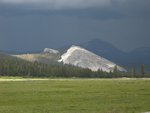The National Park Service’s abandoned mineral lands program has finalized a report summarizing a comprehensive inventory and assessment of health and safety issues related to past mineral extraction activities on national park lands.
The NPS undertook this project after the Interior Department Office of Inspector General expressed concerns about human and environmental safety problems at abandoned mineral land (AML) sites.
AMLs are lands, waters and surrounding watersheds that contain facilities, structures, improvements and disturbances associated with past mineral extraction activities. AML features include vertical shafts, horizontal openings, open pits, head frames, mill buildings, roads, drainage diversions, and piles of waste rock, ore, and tailings.
The NPS inventory determined that there are 37,000 abandoned mineral land features in 133 parks in all seven regions. The majority of abandoned mineral land features do not pose health and safety risks, and do not require remediation.
“About 10 percent of the abandoned mineral land features identified in the inventory pose a safety risk to park visitors, our employees and the environment,” said Director Jarvis. “They are a priority for remediation.”
The NPS FY2016 budget request includes $5 million to begin the project, which has an estimated total cost of more than $140 million.
Despite public safety issues and environmental degradation, mining comprises an important component of our nation’s heritage. The industrial age of the 19th and 20th centuries introduced large-scale extraction of mineral resources such as coal, copper, iron, oil, and gas, leaving significant adverse environmental impacts on the land. Some mine sites, such as the Ellis/Mariscal Mercury Mine (Big Bend National Park, Texas) and Kennecott Mine (Wrangell-St. Elias National Park and Preserve, Alaska) are listed on the National Register of Historic Places. Ongoing preservation and stabilization of historically important sites and features is a long-term maintenance need at mine sites throughout the National Park System.
“Many families, schoolchildren, and historians interested in learning about and seeing, up close, the artifacts of America’s mining history visit each year,” Jarvis said. “This project is part of our responsibility, as stewards of America’s iconic natural, historic and cultural resources, to make sure this and future generations have a positive experience.”
The NPS proposal to address safety and environmental issues is outlined in Abandoned Mineral Lands in the National Park System—Comprehensive Inventory and Assessment. This report lays out a concentrated effort over 12 years to remediate 3,800 abandoned mineral land features using trained staff and contractors. In the interim, the NPS uses temporary measures such as signs, fencing, and administrative closures to keep visitors and employees away from hazardous abandoned mineral land features.
The NPS has a successful track record in remediating these abandoned mineral land sites. Bureau staff and contractors have cleaned up 1,800 abandoned mineral land features in recent years.
The NPS AML inventory and assessment report is available at http://nature.nps.gov/geology/aml/inventory/.
Report Released On Abandoned Mineral Lands In Parks
All posts are those of the individual authors and the owner
of this site does not endorse them. Content should be considered opinion
and not fact until verified independently.
Sorry, only registered users may post in this forum.


